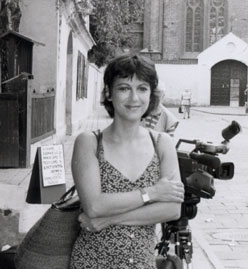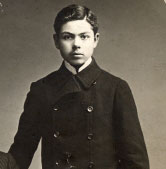 |
→ November 2004 Contents → Feature
|
Don't Give Up Your Day Job
November 2004
|
 |
||||||
|
The election, as probably for everyone, made me weary beyond words. I have nothing to add about the campaign, the election night coverage, or the outcome. I offer instead a change of pace, a piece about the making of a documentary my partner and I recently completed, "My Grandfather's House: The Journey Home." The film is about my partner and co-producer Eileen Douglas' lifelong search for the house her grandfather grew up in Kovno, Lithuania, before coming to America in 1911 and settling in Syracuse, New York. Eileen, a broadcaster, writer and author, is the center of the film. Starting in 1999, we filmed the project over five years in New York, Kovno, Lithuania, Syracuse, Washington, D.C., Tel Aviv, St. Petersburg, Russia, Baltimore, and Potomac, Maryland. After all those years, we had very little left to do, I thought. What we needed to complete the shooting proved challenging for me and important for the added touches it brought to the film.
Leonardo da Vinci. Cameramen always carried several cameras, especially on the road where repairs could be difficult. The day of the shoot, the cameraman handed me his Filmo, the small, hand-held, 16-millimeter camera with the big key-like windup gear on the outside. He would shoot the launch from ground level. He wanted me to get the high shot. "Climb that tower," he said. I gazed at the high tower that overlooked the launch site and paled. I hated and feared heights. Dutifully, because we needed the shot and we had a very small crew, I made my way up the narrow steps to the top of the tower. There, behind a railing in a catbird seat, I removed the camera from its canvas case, wound it, and shot a hundred feet, three minutes of silent film, of the launch just as an Italian princess struck the bow with a breakable bottle of Champagne. I set my lens, stayed in focus, did not shake too badly and three shots were used as cutaways to the launch. Occasionally, then, over the years, I would shoot a piece of film here and there as needed, but I did not make it a habit. In a previous documentary that aired on PBS's Channel 21 in 2003, "Luboml: My Heart Remembers," Eileen Douglas, who enjoys working with the camera, and is good at it, shot video that played an important role in the completed film. I, too, shot some video but I never used it because it was not good. Keep in mind that I am an independent filmmaker, where money is often a deciding factor in completing a production, and the possibility for either Eileen or me to shoot video is never far from my mind. As we were completing shooting our current film, it became a reality.
There are three sequences worth describing that I shot. Each presented different problems for me as the photographer (and director) who knew his material would land in the hands of an editor. Eileen had letters from some members of her family who had lived in Siberia. These were in Yiddish. She needed them translated to take the audience with us on her search. We went to the translator's apartment and I placed the two women side by side on chairs but at a slight angle. I then tried to light the scene using lamps in the living room and natural light from the windows. I used the Sony PC1, a one-chip camera, remarkable in almost every way except for shooting inside with available light. We did not have a lighting kit and the light I manufactured by moving lamps around the room helped give the picture some depth and even added a few shadows on Eileen's face. Because I could move around as Eileen talked and the two women interacted, I could get cutaways of their faces, and close-ups of the letters they were reading. I knew the editor would be able to cut the sequence with a minimum of fuss. Score one for me. There were other shots and near sequences that failed, or better put, that I did not succeed in getting. Better that I do not mention these, except to say, I will not try them again. By the way, I will include a tripod in my next budget. Never go on a shoot without one. The hand, or at least mine, is not so steady, nor really is anyone's, especially when shooting motion pictures. We wanted to see Eileen in her surroundings in New York City, walking and being active in her neighborhood. It became my next assignment. Using the PC1, I shot her on a park bench in Central Park, reading an important book about the Kovno Ghetto where many of her family had died during the Holocaust. For the few shots we used, it worked out fine. There was the wide, full-frame master shot, the usual head-on shots, and shots from all angles that gave the editor the footage she needed. In addition, because the day was sunny and bright the quality was good, hardly like a one chip camera. Continuing the theme of Eileen outdoors, I shot footage of her walking on the Upper West Side of Manhattan, also good. My next sequence is where I fell down. Eileen stopped at an outdoor flower stall. The light was still good. The flowers were colorful. It would add a nice touch to the film. I shot Eileen from two angles, right and left, but I shot nothing of her face while looking at the flowers or any tight shots of the bright flowers. My editor, a longtime friend and collaborator, Mary Perica, a woman of wonderful composure and talent, labored over making that short sequence come to life. She finally did, but when done, she turned to me and with a big, sweet grin on her face, and said, "Don't give up your day job." We laughed comfortably, and I decided to keep my day job, whatever it is, but like all independent filmmakers, especially for documentaries, I knew I would continue shooting when needed. I have no idea what my next project will be or where it will come from, but rest assured, it will include footage I shot. I got the bug. Note: "My Grandfather's House," is in release by The Cinema Guild and is available at www.cinemaguild.com. It runs 71.30.
© Ron Steinman
|
|||||||
Back to November 2004 Contents
|
|

